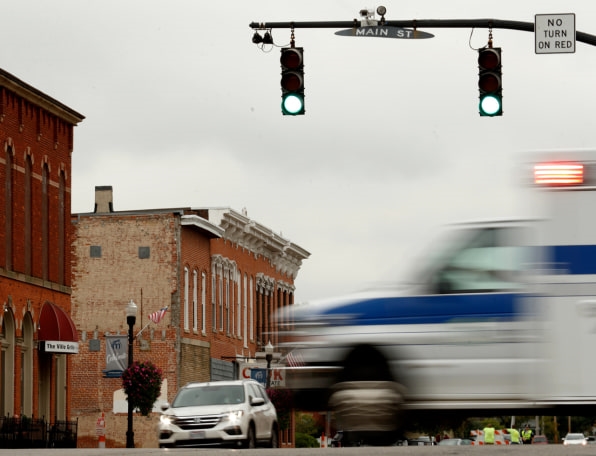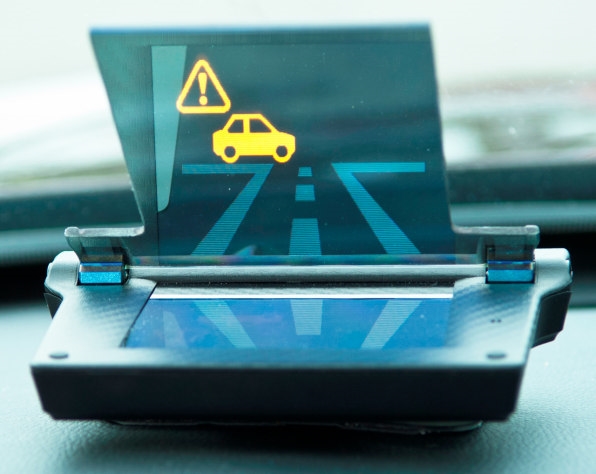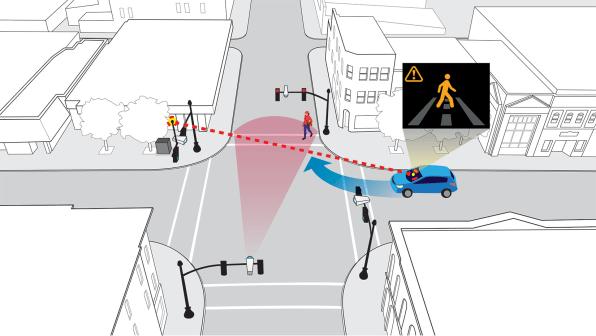If you drive up to the intersection of 5th and Main in the town of Marysville, Ohio, you’ll get a warning if a pedestrian hidden from view is about to cross the street. The town is the first to test a series of smart intersections that could improve safety.
“It’s giving the driver intelligence that will hopefully avoid crashes,” says Eric Phillips, the economic development director of the 22,000-person city, located outside of Columbus. The technology was designed by Honda, which has a local R&D center and wanted to test the tech in a real-world setting.

At the first intersection to test the technology, buildings block sight lines in every direction. If someone runs into the crosswalk, or if another car is going to run a red light, that might not be apparent to a driver until it’s too late. The new system, designed by Honda, uses four cameras mounted around the intersection and Honda’s object-recognition software, which can identify anyone or anything approaching the intersection–from a cyclist or an ambulance to a stray dog. If a crash is possible, the system beams an immediate warning to a device inside the cars that are taking place in the pilot.
“Our overarching goal is a zero-collision society,” says Jim Keller, chief engineer and senior manager overseeing the Automobile Technology Research Division at Honda R&D Americas, the division that developed the new technology. The company has been working on “connected car” technology for several years, which can be used to improve safety by making it possible for vehicles to communicate with each other. But the new intersection includes everyone on the road, not only cars.

Though the cameras are pointed at everyone passing by, Honda isn’t recording any images. “We don’t know who’s in the car or where they’re going,” says Keller. “We just know that there’s a vehicle and it’s going 37 miles an hour and it’s going to turn left, or something like that. We do use that data, but any personally identifiable data is not important and not really relevant.”
So far, only a small number of cars in Marysville have the onboard units needed to communicate with the new intersection. But hundreds of additional units will be added next year, in both cars owned by private volunteers who drive regularly in the area and cars from government and Honda fleets. The town is also adding cameras to more intersections–four are underway now for the first stage of the pilot, and ultimately, all 27 intersections in the small town will be converted. By 2020, the project expects to have 1,200 vehicles interacting with the intersections–more than 10% of all of the traffic on the road. “It’s not a huge city,” says Phillips. “You can create this playground, in a sense, for automotive companies that can test in real-life situations.” (The city is also located on the route of the 33 Smart Mobility Corridor, a highway where automakers are testing other new tech.)

Technology, of course, is not the only way to make intersections safer; other cities have experimented with changing crosswalks, shrinking the width of roads, reducing speed limits, and protecting intersections for bikes, for example. “The design of the safety of the vehicle and the bike lanes and pedestrian walkways, and how all kind of all road users interact safely, are all important,” says Keller. “I don’t think it’s like this one technology’s going to solve everything. I think we have to look at adding and combining these technologies to what makes the most sense from an economic and societal standpoint.” But the technology can also help supplement physical changes–in a roundabout intersection, for example, where American drivers are routinely confused, connected technology can tell drivers when it’s their turn to go.
It’s not clear when this type of technology might show up in cars more widely. Automakers had expected regulation from the federal government on connected cars–and had agreed on an industry standard to implement it–but when the current administration came into office, progress on regulation stalled. Still, Keller thinks that it’s coming. “Autonomous cars will have to interact with human-driven cars for many, many years to come,” he says. “So I think the more technologies we have like this smart intersection, and the work we’re doing along the smart mobility corridor, are going to be important as this transition happens between the cars of today and the cars of tomorrow.”
(46)